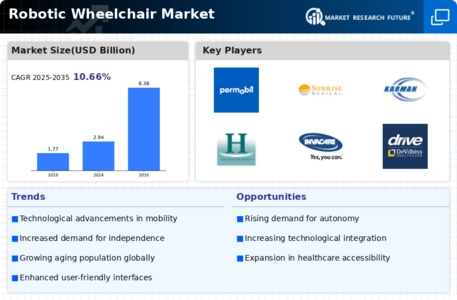Aging Population
The aging population is a significant driver of the Global Robotic Wheelchair Market Industry. As the global demographic shifts towards an older population, the demand for mobility solutions increases. Older adults often face mobility challenges due to age-related conditions such as arthritis and neurological disorders. Robotic wheelchairs offer a viable solution, providing independence and improved quality of life. Countries with rapidly aging populations, such as Japan and many European nations, are witnessing a surge in demand for these devices. This trend is expected to contribute substantially to market growth, as more elderly individuals seek advanced mobility aids to maintain their autonomy.
Rising Disability Rates
The increasing rates of disabilities worldwide are influencing the Global Robotic Wheelchair Market Industry significantly. According to estimates, approximately 15% of the global population lives with some form of disability, which includes mobility impairments. Robotic wheelchairs are designed to cater to this demographic, offering enhanced mobility and independence. Governments and healthcare systems are recognizing the need for better mobility solutions, leading to increased funding and support for assistive technologies. This growing awareness and acceptance of robotic wheelchairs as essential mobility aids are likely to drive market expansion, as more individuals with disabilities seek these innovative solutions.
Market Growth Projections
The Global Robotic Wheelchair Market Industry is projected to experience substantial growth over the next decade. With a market value of 2.94 USD Billion in 2024, it is anticipated to reach 8.38 USD Billion by 2035. This growth trajectory indicates a compound annual growth rate (CAGR) of 9.98% from 2025 to 2035. Such projections reflect the increasing demand for advanced mobility solutions driven by technological advancements, an aging population, and rising disability rates. The market's expansion is likely to be supported by ongoing innovations and improvements in robotic wheelchair technology, which will enhance user experience and accessibility.
Technological Advancements
The Global Robotic Wheelchair Market Industry is experiencing rapid technological advancements that enhance the functionality and usability of robotic wheelchairs. Innovations in artificial intelligence, sensor technology, and machine learning are enabling these devices to navigate complex environments autonomously. For instance, advanced obstacle detection systems and real-time mapping capabilities are becoming standard features. These improvements not only increase user safety but also expand the potential user base, particularly among individuals with severe mobility impairments. As a result, the market is projected to grow from 2.94 USD Billion in 2024 to 8.38 USD Billion by 2035, reflecting a robust CAGR of 9.98% for the period from 2025 to 2035.
Increased Awareness and Acceptance
Increased awareness and acceptance of robotic wheelchairs among consumers and healthcare professionals are driving the Global Robotic Wheelchair Market Industry. Educational initiatives and advocacy efforts are helping to dispel misconceptions about these devices, highlighting their benefits and capabilities. As more individuals become informed about the advantages of robotic wheelchairs, including enhanced mobility and independence, the demand is likely to grow. Additionally, healthcare professionals are increasingly recommending these devices as viable mobility solutions, further boosting their acceptance. This shift in perception is expected to contribute to the overall market growth, as more users seek out robotic wheelchairs for their mobility needs.
Healthcare Infrastructure Improvements
Improvements in healthcare infrastructure globally are facilitating the growth of the Global Robotic Wheelchair Market Industry. Enhanced healthcare facilities are increasingly adopting advanced technologies, including robotic wheelchairs, to provide better patient care. Hospitals and rehabilitation centers are integrating these devices into their services, recognizing their potential to improve patient outcomes and reduce caregiver burden. This trend is particularly evident in developed nations, where healthcare systems are investing in cutting-edge assistive technologies. As healthcare infrastructure continues to evolve, the demand for robotic wheelchairs is expected to rise, further propelling market growth.

















Leave a Comment